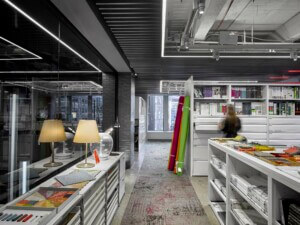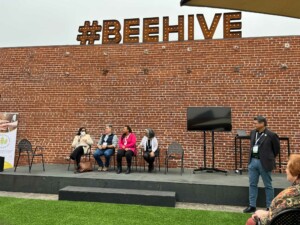July 2023 was the hottest month ever recorded. Scorching heat, droughts, a disruption of the polar jet stream, and record-high ocean surface temperatures offer just a taste of how climate change is affecting the planet. Yet while the architecture industry is making strides toward shrinking its footprint—firms are doing everything from designing tall timber towers to actively declining commissions for projects like airports— the world is in the midst of a building boom.
That’s a problem if countries want to avoid the worst impacts of climate change, as the 4 billion tons of cement produced every year accounts for 8 percent of total CO2 emissions. That’s over three times as much as the aviation industry produces (2.5 percent) and right behind the U.S. and China, the world leaders in terms of total CO2 produced by entire nations.
Portland cement—the most common type—is the binder that, when combined with particulate like sand and gravel, forms concrete. Limestone and silicate clays like feldspar, slag, and shale are sintered together in a kiln to form clinker (small balls of aggregate), which is then ground down further. The majority of emissions from cement production come from this stage, and a reduction of 4 percent in annual emissions year-over-year is required to hit net-zero emissions, according to the International Energy Agency. But in 2022, we didn’t just miss this mark: We increased these CO2 emissions by 1 percent.
With the passage of the Inflation Reduction Act in 2022, $350 million was allocated to the EPA for technical grants, product labeling, and sourcing tools to help manufacturers produce building materials with less embodied carbon and to bring awareness to consumers about these emissions-intensive materials that, ironically, make up most of our built environment. That money will also go toward increasing transparency about the embodied carbon of building materials throughout their life cycle. The U.S. Department of Energy’s (DOE) Better Climate Challenge is another avenue aimed at helping manufacturers decarbonize. The department offers grants and technical assistance to help partnered companies reduce greenhouse gas emissions by at least 50 percent within 10 years of signing on.

For companies like cement producer Holcim, which joined the Better Climate Challenge in April 2023, that involves a two-step emissions-reduction process. The first is adapting the company’s 13 U.S. cement plants to run entirely on sustainable power by 2030; the second is reducing net greenhouse gas emissions to zero by 2050. Holcim is the first cement manufacturer to partner with the DOE (the other partners are cities, like Philadelphia, and consumer-facing companies, like Kohl’s and 3M).
Holcim has developed a new type of cement that it hopes will lead the sustainability charge. The company reports that producing its ECOPlanet cement creates 30 percent less emissions, even though the result is a material just as strong as Portland cement. It’s able to achieve those reductions by introducing slag and other industrial byproducts into its mix. Taking things one step further, Holcim’s ECOPact concrete, which uses ECOPlanet cement and recycled aggregate made from cast-off building material, is already widely available. At the Robert A. M. Stern Architects–designed ELEVEN, a 41-story, 550-foot-tall condo tower in Minneapolis, more than 9,000 cubic yards of ECOPact were used, and Holcim estimates that the switch reduced emissions in the production by 32 percent compared with a typical concrete mix.
There are also companies and research initiatives taking a slightly different approach to decarbonization. Some are looking to grow cement from biological sources and skip the mining, refining, and grinding altogether. The Colorado-based start-up Prometheus Materials began at the University of Colorado Boulder in response to a 2016 building materials grant from the U.S. Department of Defense to use “living materials.” These materials were to be easily grown and able to bind with local, in-situ aggregates, with the goal of protecting high-value assets. Although the brief was more focused on material durability, Prometheus CEO Loren Burnett said the resultant cement replacement also happened to produce zero emissions.
Prometheus is growing cyanobacteria (algae that photosynthesize carbon dioxide into calcium carbonate, the same mechanism shells and coral are built with) in bioreactors using LED lighting that mimics natural daylight. Ambient air from the room is pumped into a tank containing the algae; this supplies the CO2. The algae are then harvested and transferred to a second tank that stimulates calcium carbonate production. This process is complete when all the algae sink to the bottom of the tank, where they’re then collected, dehydrated, and mixed with other natural binding agents. The result is a bio-cement; it’s then ready to be mixed with aggregates to create concrete. When asked whether Prometheus was also seeking to replace the aggregates, Burnett said the company is actively “looking into sustainable replacements for traditional concrete aggregates, including crushed glass, mirror, and shredded rubber” salvaged from construction sites for a true cradle-to-cradle material.

In July 2022, Prometheus Materials closed its Series A funding round, led by European venture capital firm Sofinnova Partners, with $8 million. Funders included industry luminaries like the Microsoft Climate Innovation Fund, SOM, roofing giant GAF, and the Autodesk Foundation. According to Burnett, as Microsoft ramps up construction of data centers around the world, the company wants to use Prometheus’s bio-composite cement to help hit its sustainability targets. The company has also added PAU founder Vishaan Chakrabarti to its board of directors: Burnett said he watched a video on the environmental costs associated with concrete production that featured Chakrabarti and was so inspired that Chakrabarti was subsequently offered the role.
The material, according to Prometheus, outperforms traditional concrete in flex-roll strength by up to four times. It’s 90 percent less thermally conductive, and Prometheus even boasts that its bio-composite concrete is up to 12 times better at absorbing sound, opening up a broad range of applications. Thus far, the bio-composite has received American Society for Testing and Materials C90 (load-bearing concrete masonry units) and C129 (non-load-bearing CMU) certifications. Accordingly, the Series A funding is being used to develop a line of CMU blocks, permeable pavers, acoustic panels and tiles, and potentially even thermal panels as Prometheus puts out its first “go-to-market” products to establish a foothold in the space.
Prometheus Materials is currently in its Series B funding round, which it expects to close before the end of the year. Then, in the first half of next year, the company plans to use that funding to build out a new precast production facility so it can begin selling products at scale. Rather than attempting to compete with traditional cement and concrete manufacturers, the company wants to license its technology to other companies worldwide and then ship cement mix produced at the factory to licensees as a drop-in product replacement in their own lineups.
The MIT Media Lab is also investigating a similar material, a bacterial bio-cement grown through a similar process around aggregate. This research takes things one step further than Prometheus’s work, prefiguring a world where bacteria has formed a living, embedded web in bricks that can relay pollution measurements or structural health by changing color. While this technology is much more in the realm of theoretical, it’s not hard to imagine a future where even concrete buildings can be built as embodied carbon sinks and relay information without deep technical analysis.
Jonathan Hilburg is an electronics editor at Reviewed who focuses on gaming. Previously, he was The Architect’s Newspaper’s web editor. He lives in Manhattan and is keenly interested in the intersection of art, architecture, and context.











